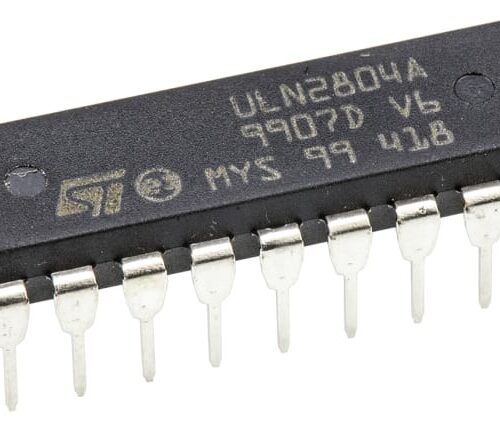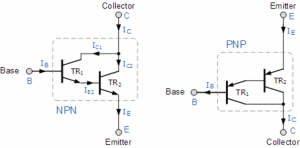ULN2804A
Part Number: ULN2804A
Manufacturer: STMicroelectronics
Description: Darlington Transistors
Shipped from: Shenzhen/HK Warehouse
Stock Available: Check with us
ICRFQ.com - Electronic Components Distributor in China Since 2003

Part Number: ULN2804A
Manufacturer: STMicroelectronics
Description: Darlington Transistors
Shipped from: Shenzhen/HK Warehouse
Stock Available: Check with us
| Datasheet | |
|---|---|
| Category | Discrete Semiconductor Products |
| Family | Transistors – Bipolar (BJT) – Arrays |
| Manufacturer | STMicroelectronics |
| Series | – |
| Packaging | Tube |
| Transistor Type | 8 NPN Darlington |
| Current – Collector (Ic) (Max) | 500mA |
| Voltage – Collector Emitter Breakdown (Max) | 50V |
| Vce Saturation (Max) @ Ib, Ic | 1.6V @ 500μA, 350mA |
| Current – Collector Cutoff (Max) | – |
| DC Current Gain (hFE) (Min) @ Ic, Vce | 1000 @ 350mA, 2V |
| Power – Max | 2.25W |
| Frequency – Transition | – |
| Mounting Type | Through Hole |
| Package / Case | 18-DIP (0.300″, 7.62mm) |
| Supplier Device Package | 18-DIP |
Eight common-emitter Darlington transistors with built-in inductive load suppression diodes are found in the ULN2804A. Each Darlington has a 600 mA peak load current rating (500 mA continuous rating) and can resist at least 50 V in the OFF state. It is possible to parallelize outputs to enhance current capacity.
It has the practical input-opposite-output pinout, which makes the board layout simpler, and is available in an 18-lead plastic DIP with copper leads. But first, a brief introduction to Darlington transistors before we move on.
Sidney Darlington invented the transistor and gave his name to the device we now know as the Darlington transistor. Connecting two bipolar junction transistors, PNP or NPN results in constructing a Darlington transistor. It is possible to produce a sensitive transistor with high current gain by connecting the emitter of one PNP transistor to the base of another PNP transistor.
This transistor type is useful in various applications where switching or amplifying signals is essential. It is possible to build the transistor pair used in the Darlington transistor using two BJTs coupled to one another in separate circuits. As a transistor may act as a switch and an amplifier, a BJT can serve as an on/off switch.
A Darlington transistor, also known as a Darlington pair, is a piece of electronic equipment that connects two BJTs (Bipolar Junction Transistors) to enable a very high amount of current gain. This configuration results in the creation of a device that is referred to as a Darlington transistor. This is accomplished through a compounding amplification, in which the first transistor amplifies the current and is further amplified by the second transistor.
This particular transistor is known as a “Darlington Pair” because its compound structure is created from two BJTs. Because it only possesses a single emitter, collector, and base, this transistor operates similarly to a single transistor unit. In 1953, Sidney Darlington came up with the idea for what would later be known as the Darlington transistor.
If the current gain of a transistor is 1 and 2, then the overall current gain of a Darlington pair is 12. This transistor has an exceptionally high current gain compared to a standard transistor. Consequently, the transistor is also called a “Super Beta Transistor.”
The Darlington Transistor comprises two PNP or NPN transistors coupled to each other in a back-to-back configuration. Both transistors share a single package with a shared collector terminal, and it is a single package overall.
A connection has been made between the second transistor’s base terminal and the first transistor’s emitter terminal. Therefore, the base supply is only provided to the first transistor, while the output current is only drawn from the second transistor. Both of these transistors are connected in series. As a result, it has a single base, a single emitter, and a single collector, as demonstrated in the image below.

When both of the Darlington pair’s transistors are PNP varieties, the resulting device is referred to as a PNP Darlington Transistor. An NPN Darlington Transistor is formed when the Darlington pair is composed of two NPN transistors. The following illustration provides a connection diagram that may apply to NPN and PNP Darlington Transistors.
Both varieties of transistors share the Collector terminal. Neither kind has a dedicated Collector terminal. When a PNP transistor is used, the base current is sent via the second transistor and into its emitter terminal. Additionally, in an NPN transistor, the current from the emitter is routed to the base terminal of the second transistor.
Compared to the amount of space necessary for two individual transistors, the amount of space needed for a Darlington transistor is significantly smaller since the collector terminal of both transistors is shared in this configuration.
Compared to a standard transistor, the Darlington transistor, also known as a Darlington pair, possesses several advantageous qualities. The following is a list that provides a summary of these points:
The following is a list that provides a concise summary of the drawbacks associated with using a Darlington transistor, often known as a Darlington pair:
The ULN2804A from STMicroelectronics is a DIP-packaged, eight-Darlington through-hole array. With common emitters and built-in suppression diodes, the array’s eight Darlington transistors are able to handle inductive loads with ease. Each Darlington can withstand a minimum of 50 volts when it is in the OFF state and has a maximum load current rating of 600 milliamperes (500 milliamperes continuously).
Additionally, a 10.5 kilohm input resistor for 6 to 15 volts CMOS is included to make the connection to standard logic families easier.
There are eight common-emitter Darlington transistors in it.
As a leading developer and provider of semiconductor solutions for various microelectronics applications, STMicroelectronics is a global independent semiconductor corporation. The Company is at the cutting edge of System-on-Chip (SoC) technology. Its solutions are essential in supporting today’s convergence trends because of an unmatched combination of silicon and system knowledge, Intellectual Property (IP) portfolio, manufacturing strength, and strategic partners.
We hope this article will help you in your projects. If you have any questions about this article or any other article on our website, feel free to post them in the comment sections below, and we will do our best to answer them then.
We at ICRFQ are a global supplier of every electronic component you may need. Get in touch with us today, and we will provide you with the lowest prices on the highest quality.
WhatsApp us